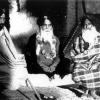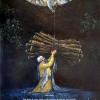Search the Community
Showing results for tags 'ji'.
-
WARNING: IF YOU ARE GOING TO COMMENT ON MY POSTS, PLEASE BE MATURE AND ONLY USE FACTS, NO DRAMA PLEASE Waheguru Ji Ka Khalsa, Waheguru Ji Ki Fateh! Sikhs often love to claim that their "holy book" (Ignore the Abrehamic context) was written and sealed by its founders, and Sikhs still use the same version to this day. However, there have been numerous controversies over the validity of certain passages (you all know what im talking about). Since the original Saroop of the Guru that was written by Bhai Mani Singh Ji and overlooked by Guru Gobind Singh Ji at damdama sahib in 1708 has been lost, and numerious others were destroyed as recently as in 1984 by the Indian Government (they still refuse to give some back), how will have Sikhs preserved the Siri Guru Granth Sahib Ji?
-

Got told off for calling Guru Gobind Singh, Guru Nanak
Redoptics posted a topic in WHAT'S HAPPENING?
I'm I wrong, I saw a picture of Guru Gobind Singh Ji, I called him Guru Nanak Ji, people shouted at me abs swore, am I wrong or right. -
Who exactly reviews english translations? As i read a lot of different versions, which is right? We really need to sort this out as it distorts the truth.
-
Waheguru ji ka khalsa waheguru ji ki fateh, dhan dhan sri Guru gobind singh ji writes "vaar sri bhagouti ji ki" in the beginning of chandi di vaar. Then maharaj says "inder jeha jodha maitho bhajia." So is maharaj speaking from his point of view or the bhagoutis point of view? bhul chuk maaf karni waheguru ji ka khalsa waheguru ji ki fateh
-
Waheguru Ji Ka Khalsa. Waheguru Ji Ki Fateh! Often times I hear people say "SGGSJ doesnt say (insert topic) so it must be ok", and in the case of pre-marital sexual relations a dear friend of mine has made the same argument. My friend (non khalsa) argues that Bani specifically condemns rape, adultery, and polygamy, however isnt against sex outside of marriage, provided that both are not married to anyone, and have given consent. My friend likes to disregard anything outside SGGSJ. He brings up tuks from Gurbani that specifically mention "others wives" to support the argument that its specifically about adultery, however I would argue, the English translation is very shallow, and in the context of Bani, "others wives" is also talking about anyone who isnt your wife, and isnt limited to adultery, but also anyone who isnt married. Example 1: Siri Guru Granth Sahib Ji, Ang 274 ਪਰ ਤ੍ਰਿਅ ਰੂਪੁ ਨ ਪੇਖੈ ਨੇਤ੍ਰ ॥ Par Thria Roop N Paekhai Naethr || ਪਰ means other ਤ੍ਰਿਅ means wife Example 2: Siri Guru Granth Sahib Ji, Ang 1013 ਇਸਤ੍ਰੀ ਤਜਿ ਕਰਿ ਕਾਮਿ ਵਿਆਪਿਆ ਚਿਤੁ ਲਾਇਆ ਪਰ ਨਾਰੀ ॥ Abandoning his own wife, he is engrossed in sexual desire; his thoughts are on the wives of others. Context: Its not just talking just about adultery, the English translations are limiting, generally the concept is to not covet another wife, in the context of Bani, doesn't mean you can have sexual relations with women who are not married. Our rehat and history make it clear that one cannot have any sexual relations outside of marriage. There is a specific reason the Guru had 10 forms over 200 years, it was to show Sikhs how to live and practically apply Bani, otherwise the SGGSJ would have been all compiled by Guru Nanak and there would be no long history of the Guru in his many forms. The SGGSJ isnt a rule book, and isnt going to specifically ban everything that we know is immoral. Where in SGGS Ji does it say that Sri Guru Har Rai Sahib Ji was the 7th Guru Sahib after Sri Guru Hargobind Sahib Ji? Why would a primary Sikh text not name him? In terms of Gurbani, when taken into context, and even compared to rehat and our history, its clear that sexual relations outside of marriage are discouraged. Do you agree with my argument? These are just a few tuks I decided to bring up, if anyone has any more, please feel free to share!
-
There is a big difference between a musical performance and kirtan. A performance is to display how good you are at something. In kirtan you don't have to prove anything, you have to get connected. That is the puropose of kirtan; to get connected yourself, and to help others get connected as well. In a musical performance the main focus is on the notes and rhythm. In kirtan the focus is on the Shabad. The Shabad is transmitted through the kirtan. Music is the presenting tool. It is the plate that you use to serve up the Shabad. The proper way to do kirtan is to please the Guru, don't please the audience. If you please the Guru and the audience is connected to the Guru then they will be pleased. If you are trying to please the audience, you might cross the line where your Guru will get unhappy with you. Kirtan is the original form of Bani. Bani was first sung and written later on. Source - http://www.sikhnet.com/videos/difference-between-music-and-kirtan?utm_source=feedburner&utm_medium=feed&utm_campaign=Feed%3A+SikhnetNews+(SikhNet+News)
-
Recently while reading some website i came across an article about pictures of the Gurus that were painted during there own time and how we still have them. On Page 5 of the article there mentioned how in Baghdad Guru Nanak Ji Maharaj give permission to the king of Baghdad to paint Guru Sahibs Picture. In the article it mentions that a European named William Ouseley published a book in 1797 call "oriental Collections vol II". William Ouseley found this picture of Guru Sahib in a Baghdad palace and put the picture in his book. I searched for the book and found it, where it has Guru Ji's picture. There are two pages one gives a brief description and the second has the picture. Here are the pages with the pictures
- 50 replies
-
10
-
Bhai Seva Singh Ji http://www.gurmatveechar.com/books/Steeks_and_Teekas/Bhai_Gurdas_Ji_Steeks/Kabit.Bhai.Gurdas.Ji.by.Bhai.Seva.Singh.(GurmatVeechar.com).pdf Giani Mani Singh Ji Pt.1 http://www.gurmatveechar.com/books/Steeks_and_Teekas/Bhai_Gurdas_Ji_Steeks/Vaaran.Bhai.Gurdas.Ji.Part.1.by.Giani.Mani.Singh.(GurmatVeechar.com).pdf Giani Mani Singh Ji Pt.2 http://www.gurmatveechar.com/books/Steeks_and_Teekas/Bhai_Gurdas_Ji_Steeks/Vaaran.Bhai.Gurdas.Ji.Part.2.by.Giani.Mani.Singh.(GurmatVeechar.com).pdf Bhai Vir Singh Ji http://www.gurmatveechar.com/books/Steeks_and_Teekas/Bhai_Sahib_Bhai_Vir_Singh/Bhai.Gurdas.Dian.Veeran.Di.Steek.by.Bhai.Vir.Singh.(GurmatVeechar.com).pdf Bhai Vir SIngh JI http://www.gurmatveechar.com/books/Steeks_and_Teekas/Bhai_Sahib_Bhai_Vir_Singh/Kabit.Bhai.Gurdas.by.Bhai.Sahib.Bhai.Vir.Singh.(GurmatVeechar.com).pdf
-
Baba Ji used to recite the prayer called Chandi di Vaar daily, as part of his Nitnem This is a prayer composed by the tenth Guru, describing a battle between demons and the Goddess called Chandi. It is usually recited by Sikhs during war. Many a time, a question would arise in his mind as to, how many times and at what time one should recite the prayer of Chandi di Vaar? Baba Ji asked many Saints and sadhus regarding this question, but could not get a satisfactory answer. One evening, at his room in the fields, after reciting the evening prayer of Rehras, Baba Ji went on to recite the prayer of Chandi di Vaar. After completing this prayer, he prepared to retire by saying his last prayer of Sohila. It was a moonlit night and the doors of the room in which he was sitting, were open. As he had just lain down, he noticed two men approaching at a short distance. Baba Ji thought to himself, that if these pedestrians were just travellers, he would offer them food and shelter for the night and if they were robbers, then he would challenge them in combat. No sooner had this thought entered his mind, than miraculously one of the Singh’s came beside him and grabbed his feet. The other one seized Baba Ji’s head and pinned him down onto the bed. Baba Ji used to tell us, “I was unable to move from the bed. A thought entered my mind that these two, who have moved faster than the speed of light in order to grasp me are neither robbers nor travellers. These two must be Shaheed Singhs (the immortal souls of Sikh martyrs). I began to recite the Mool mantar I had only uttered the Mool mantar twice when the Singh who held my head down, let go, followed by the second Singh who was holding my feet.” Baba Ji got up and the Shaheed Singh explained, “We did not come here to fight with or seize you, but to answer your question, regarding the correct time to recite the prayer of Chandi di Vaar. As you thought about offering us a fight, we came and immediately seized you, as we did.” The Shaheed Singh continued, “If you start reciting the prayer of Chandi di Vaar after sunset then, one must keep reciting it 64 continuously through the night until dawn. Two or more Singhs may take turns to recite this prayer through the night, it is all right to do so. One must sit upon a clean mat or bed, bathing before reciting the prayer. An oil lamp lit with clarified butter should be kept alight throughout the night. During the day, one can recite Chandi di Vaar as many times as one wants. There is no specific practice to reciting the prayer except that one reads the prayer with devotion and understanding.” After explaining these instructions, the Singh’s disappeared through the doors towards the direction they came from.
-
Waheguru Ji Ka Khalsa Waheguru ji Ki Fateh, I was wondering if anyone has full Guru Granth Sahib Ji Katha? I have tried to listen to Sant Giani Baba Gurbachan Ji Khalsa Bhindranwale's but the audio is not not clean. So can anyone provide a link or download to Full Katha that is easy to hear and digitally clean.
- 3 replies
-
- guru granth sahib
- guru
-
(and 3 more)
Tagged with:
-
Waheguru Here is the entire Bhai Bala Wali Janamsakhi in audio Janam Sakhi Guru Nanak Dev Ji 001 - Saakhi Avtar Dharan di Janam Sakhi Guru Nanak Dev Ji 002 - Saakhi Pande Kol Parhan Di
-
Sangat, please relish. Anti-Sants - You are requested not to start any Sant mahapurkh Ninda here. "Kai kehnde ne ena de kaphre rang birange ne, koi puche, jina de chite paye ne, ona de piche kehrha aapan thaal lai firde aa" Part#1 http://www.youtube.com/watch?v=Nva26oprFKA Part#2 http://www.youtube.com/watch?v=EqH6Q2dhMdE Part#3 Part#4 http://www.youtube.com/watch?v=DDU3SJBQ_Rk Part#5
-
Wahegurujikakhalsawahegurujikifateh There was a Bhagat from Lahore called Chajju. One day at his door two labourers were stood outside. At the time it was raining. Bhagat Chajju looked at the labourers and asked why they were stood outside his door. They looked at Bhagatji and said that they work for a living outdoors doing labour. Their condition was such that when they didn't work, they didn't eat. They explained to Bhagatji that when it rains they don't find much work. As a consequence they had come to Bhagat Chajjuji's door in the hope of finding some work. Bhagatji invited them into his house to offer them work . He said not only will I feed you - sugar and koi - but I will pay you double your usual rate. Bhagatji offered 8 annas instead of the 4 annas the labourers were usually paid for a days work. Bhagatji then sat the two labourers down, gave them malas and said sit down and doing abhiyaas of Raam. At the end of the day Bhagatji fed the labourers and paid them 8 annas. He then told them come here daily and partake in this work and I will continue to pay and feed you in this way. The labourers looked at Bhagat Chajjuji and said this work is too difficult to do. We would rather lift and break stones than do hard manual labour than this work... Loose translation of Katha by Sant Gyani Baba Gurbachan Singh Ji Bhindranwale Why is it so hard? Wahegurujikakhalsawahegurujikifateh
-
Wahegurujikakhalsawahegurujikifateh One time Sant Baba Bishan Singh Ji, the 10th jathedhar of Satguru Sri Guru Gobind Singh Ji's Damdami Taksal decided to visit Amritsar and in particular Sant Baba Shaam Singh Ji. Sant Baba Shaam Singh Ji was the kirtani of Sachkhand Sri Harmandir Sahib Ji who had spent over 90 years doing seva with his Sarandha. Sant Baba Bishan Singh Ji and the jatha had done darshan at Harmandir Sahib Ji and then began to make their way to the asthan of Santji. As they reached there they found an old singh cleaning the sewer/drain. They asked where Sant Baba Shaam Singh Ji was and were advised by the old Gursikh to go inside the asthan and sit down and Santji would be with them soon. The old Gursikh then did Panj ishnaan and went and sat in front of them. When he did this he was asked again that they wished to have darshan of Sant Baba Shaam Singh Ji - the old Gursikh relied that the vessel sat before them was Sant Baba Shaam Singh Ji. Waheguruji... May Maharaj bless with with such humility. Loose translation of Katha by Giani Ram Singh Ji Wahegurujikakhalsawahegurujikifateh
-
Bhai Harpal ji requested to Guru sahib to get bless with sewa. Guru sahib said sewa is very hard. But bhai ji insisted. Guru sahib said ok. Once Guru sahib saw a parrot, and asked bhai ji to bring that parrot to HIM. Bhai sahib said satbachan and went to the owner. The owner was a pathan, who knew that a Sikh would do anything for his Guru, so he said you won't be able to pay for it. But Bhai ji said he can give his life to get it. Pathan said ok, you have to give your sister in return. Bhai sahib said ok and went home. His mother was doing path, bhai sahib said "maa bani parhdi e". She said ha, bhai said "aaj bani te chaln da sama aa geya. Family agreed and bhai sahib went with his sister to pathan, Pathan said now I want your daughter as well. Bhai sahib said ok, sent his daughter and took the parrot. Bhai sahib went to Guru sahib, give the parrot and sat back near jorhe, without even explaiing how he got it, instead was praying Guru sahib, please forgive me, it took me so long, tuhade bachan manan layi" And pathan on the other side, asked girls to become his begams, Girls said they'll do anything, even janitorial work but not this and said : eh dil hai amanat di satguru di, tha tha te lagayea nai janda, ansi kite kaul nibhavge, nadia tar ke javange, ha, ansi rukhrha sham manavenge, saatho jagat manaeya nai janda eh dil hai amanat di satguru di, tha tha te lagayea nai janda, ansi duniya valon udaas hoye, ode charna de daas hoye, bhawein fail howe bhawein pass howe, piche kadam hataeya nai janda, eh dil hai amanat di satguru di, tha tha te lagayea nai janda, When pathan tried to touch them, he became blind and begged the girls to take him to Guru sahib. He went blind because of Bhai sahib's sacrifice and girls love & faith on guru sahib. They went to Guru sahib and he apologised. Sewak got passed in the examination and "nindak de moonh kale hoye". Guru sahib ji was very happy at Bhai ji, stood up when bhai sahib came & hugged him & asked bhai Harpal ji that he can get all of his wishes fulfilled, but Bhai sahib begged for below: mera sir tere charna ch howe, jadon meri jaan nikle jadon jaan nikle, jadon pran nikle From Sant Baba Balwant Singh ji urmur Tandewale Deewan "Satguru ki sewa 1"
-
Wahegurujikakhalsawahegurujikifateh, Came across these videos some time ago. Mahapursh sat in their own mauj listening to Dhur Ki Bani...is there anything more beautiful? For those of you who don't know Sant Baba Joginder Singh Ji did seva at Sachkhand Sri Hazur Sahib for over 40 years - for 12 of these he didn't utter a single word and instead was engrossed in naam abhiyaas. Wahegurujikakhalsawahegurujikifateh
-
Wahegurujikakhalsawahegurujikifateh One time Sant Sundar Singh Ji Bhindranwale was taken to hospital with an illness. The Chief Khalsa Divan honorary secretary Dr. Diwan Singh Ji came to the hospital to have darshan of Mahapursh. Dr. Diwan Singh Ji had done darshan of many Brahmgyanis including Sant Baba Shaam Singh JI - the kirtani of Sachkhand Sri Darbar Sahib Ji. After exchanging Fateh with Santji he asked/did a benti to Santji to give a Bachan. Santji simply said I'm ill what Bachan can I possibly give? Santji then asked Dr. Diwan Singh Ji to examine him and begin some treatment. Dr. Diwan Singh Ji then proceeded to narrate an experience from his own life. He said to Santji that every time I switch on my car - from the engine itself I hear 'waheguru waheguru waheguru waheguru waheguru Dhan Guru Nanak Dev Ji waheguru waheguru waheguru waheguru waheguru'. Santji said you have a lot of bakhseesh and kirpa bestowed on you by Guru Sahib. Dr. Diwan Singh Ji then said I've told you about this kirpa now please give a Bachan. Santji smiled and said I will give Bachan but before that you are a doctor, please examine me and treat me. Hearing this Dr. Diwan Singh Ji took out his stethoscope and begin to examine Santji. Everywhere the stethoscope was placed only one thing was heard - Waheguru waheguru waheguru waheguru waheguru. This is the Nishani of a Gursikh. Very loose translation from katha by Giani Ram Singh. How my ears and my stethoscope long to meet a patient like Santji. Wahegurujikakhalsawahegurujikifateh
-
Wahegurujikakhalsawahegurujikifateh, Has anyone read this book on Sri Zafarnama Sahib Ji? If so what did you make of it? Is it worth buying? The following is a book description on Amazon: Louis E. Fenech offers a compelling new examination of one of the only Persian compositions attributed to the tenth Sikh Guru, Guru Gobind Singh (1666-1708): the Zafar-namah or 'Epistle of Victory.' Written as a masnavi, a Persian poem, this letter was originally sent to the Mughal emperor Aurangzeb (d. 1707) rebuking his most unbecoming conduct. Incredibly, Guru Gobind Singh's letter is included today within the Sikh canon, one of only a very small handful of Persian-language texts granted the status of Sikh scripture. As such, its contents are sung on special Sikh occasions. Perhaps equally surprising is the fact that the letter appears in the tenth Guru's book or the Dasam Granth in the standard Gurmukhi script (in which Punjabi is written) but retains its original Persian language, a vernacular few Sikhs know. Drawing out the letter's direct and subtle references to the Iranian national epic, the Shah-namah, and to Shaikh Sa'di's thirteenth-century Bustan, Fenech demonstrates how this letter served as a form of Indo-Islamic verbal warfare, ensuring the tenth Guru's moral and symbolic victory over the legendary and powerful Mughal empire. Through analysis of the Zafar-namah, Fenech resurrects an essential and intriguing component of the Sikh tradition: its Islamicate aspect. Gururakha, Wahegurujikakhalsawahegurujikifateh
-
Wahegurujikakhalsawahegurujikifateh Recently I have seen a lot of posts talking about Sant Jarnail Singh Ji's Avastha and Jeevani. For those who want to know more about Santji's amazing spiritual jeevani - please watch the following videos Punjabi English Sant ALWAYS comes before sipahi. Wahegurujikakhalsawahegurujikifateh
-
Wahegurujikakhalsawahegurujikifateh, I'm doing some research into the Das Grahin currently. Compassion Charity Forgiveness Cleanliness Control of mind Purity Appreciation of truth Spiritually accomplished being Warrior Devotee to God and no other Does anyone know which ang in Sri Sarbloh Granth Sahib Ji Guru Sahib has written about these ten qualities/virtues? Wahegurujikakhalsawahegurujikifateh
-
Wahegurujikakhalsawahegurujikifateh One time a bibi who lived in Amritsar had a child who had contracted some long term illness. The mother took the child to hospital but despite several treatments the child failed to get better. Day and Night would be spent at her child's bedside - looking after its every need. One day she caught a glimpse of Sant Baba Shaam Singh Ji the beloved kirtani of Satguru Sri Guru Raam Das Ji Maharaj's house - Sachkhand Sri Darbar Sahib Ji. A thought came into her head as she saw him. He is a Sadhu, a Mahapursh, a Bhramgyani - if there is anyone who can make my child better its him. In this way she decided to go very early in the morning and leave her child on the street that Sant Baba Shaam Singh Ji would walk on as he made his way to Sachkhand Sri Darbar Sahib. When Mahapursh was walking to Darbar Sahib at amritwela - he saw a child had been left by the side of the road. He picked up the child and carried it with him to Sachkhand Sri Darbar Sahib. Whilst carrying the child he was singing the praises of Akaal Purakh. Santji began to see that the child he was holding was very lethargic and unwell. As a consequence he sprinkled water from the Amrit Sarovar and began to recite Sri Sukhmani Sahib Ji. Eventually Santji after spending the day at Sachkhand Sri Darbar Sahibji Santji took the child back to Dharamsala Sri Guru Nanak Devji Dasan Das Shaam Singh. All along the child's mother had followed Santji and now she entered the Gurudwara Sahib. When she saw that her child was very alert and playful she fell at the feet of Sant Baba Sham Singhji. Santji realised she was the mother of the child and immediately said why are you thanking me? I have done nothing! Go to Teerath Raaj Maharaj Sri Amritsar Sahib - and thank Satguruji the king of kings, the saint of saints and the ocean of compassion. It is the house of Guru Nanak Dev Ji, it is their bani, their very form which has bestowed this kirpa on you and your child. Wahegurujikakhalsawahegurujikifateh








